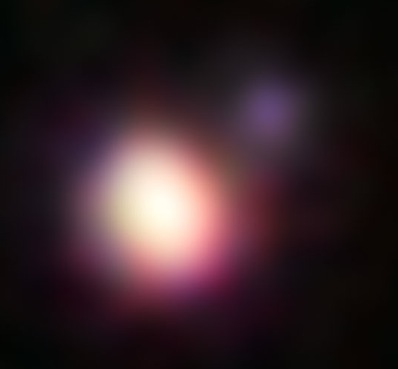



|

|

Brown dwarf pair
cool as coffee
DR EMILY BALDWIN
ASTRONOMY NOW
Posted: 24 March 2011


Using ESO's Very Large Telescope (VLT), astronomers have detected a pair of brown dwarf stars, one of which barely exceeds the temperature of a freshly made mug of coffee – extraordinarily cold for a stellar surface.
The star could be the coolest brown dwarf detected yet, and, living up to its nickname of a 'failed star' (brown dwarfs lack the mass and gravity to trigger the nuclear reactions required to fuel stars) further blurs the line between cold stars and hot planets. “We were very excited to see that this object had such a low temperature, but we couldn’t have guessed that it would turn out to be a double system and have an even more interesting, even colder component,” says Philippe Delorme of the Institut de planetologie et d’astrophysique de Grenoble.

This image of the brown dwarf binary CFBDSIR 1458+10 was obtained using the Laser Guide Star (LGS) Adaptive Optics system on the Keck II Telescope in Hawaii. The colour picture was created from images taken through four different filters at near-infrared wavelengths. Image: Michael Liu, University of Hawaii.
The coolest of the pair, simmering away at just 100 degrees Celsius, is known as CFBDSIR 1458+10B, and is located 75 light years from Earth. For comparison, the temperature of the Sun's surface is over 5,500 degrees Celsius. “At such temperatures [100 degrees Celsius] we expect the brown dwarf to have properties that are different from previously known brown dwarfs and much closer to those of giant exoplanets – it could even have water clouds in its atmosphere,” says Michael Liu of the University of Hawaii’s Institute for Astronomy. “In fact, once we start taking images of gas-giant planets around Sun-like stars in the near future, I expect that many of them will look like CFBDSIR 1458+10B.”

Artist's impression of the cool brown dwarf pair. Image: ESO/L. Calçada
The stars were resolved using the Laser Guide Star (LGS) Adaptive Optics system on the Keck II Telescope in Hawaii – when the system was first announced it was thought to just be one star – and the distance obtained using the Canada-France-Hawaii Telescope. ESO's VLT was then used to extract the temperature of the system. Initial measurements find that the stars orbit each other once every thirty years, with a separation of about three times the Earth-Sun distance. The two objects are comparable in size to Jupiter, but the team plan to map the binary system's orbit over a period of ten years in order to better determine the stars' masses.
The initial results will be published in the Astrophysical Journal.
|

|

|

|
|



